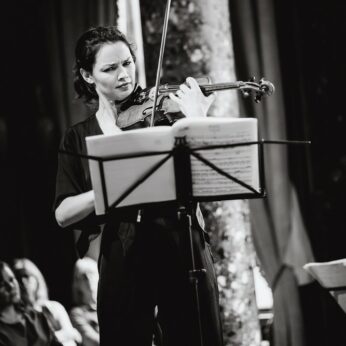Composer: Leoš Janáček (b. 1854 - d. 1928)
Performance date: 24/06/2022
Venue: St. Brendan’s Church
Composition Year: 1921
Duration: 00:16:36
Recording Engineer: Jason Fallon, Ergodos
Instrumentation: vn, pf
Instrumentation Category:Duo
Artists:
Mairead Hickey -
[violin]
Nathalia Milstein -
[piano]

Leoš Janáček [1854-1928]
Sonata for violin and piano [1921]
1. Con moto
2. Ballada
3. Allegretto
4. Adagio
Janáček wrote the first version of this sonata as the threat of war hung over Europe in the late summer of 1914. Like many Czech nationalists, Janáček expected the Russians to sweep through the Balkans and liberate them from Austrian rule. As this vision faded, the composition of the sonata foundered and it was 1921 before he managed to complete it.
Janáček was above all a composer of highly dramatic operas and this flair for drama overflows into his chamber music. The first movement is a highly dramatised confrontation between two diametrically opposed ideas – a passionate opening theme and a much calmer, more hesitant and questioning thematic cell. The clash between these conflicting states of mind or opposed personalities creates an explosive mixture.
The slow movement had an autonomous prior existence before becoming the Sonata’s second movement. Janáček finds an exhilarating folk-like theme to act as his refrain and contrary to his normal shortness of melodic breath, he allows this hypnotic theme to blossom and flourish to the everlasting gratitude of violinists and audience alike. Much of the romantic effect of this marvellous movement is achieved by increasing the tension with pianissimo glimpses of the melody rather than the full-blooded release, though there is certainly no lack of passion either.
In the third scherzo-like movement, vicious cutting ripostes from the violin are imposed on a cheerful tune in the piano, followed immediately by a dreamy trio, where the violin abruptly changes mood. In the finale, the piano tries a more expansive idea, which the muted violin again rudely interrupts. A second dolce subject again changes the mood. The two juxtaposed motifs return in the development, which builds to a passionate climax, the piano’s expansive theme being taken over by the violin with the melody soaring ever higher, both instruments in passionate accord. After this high drama the conclusion of the movement is increasingly downbeat and disillusioned, the last bars in particular.
Francis Humphrys
Copyright © 2024 West Cork Music. All rights reserved.
Designed and developed by Matrix Internet